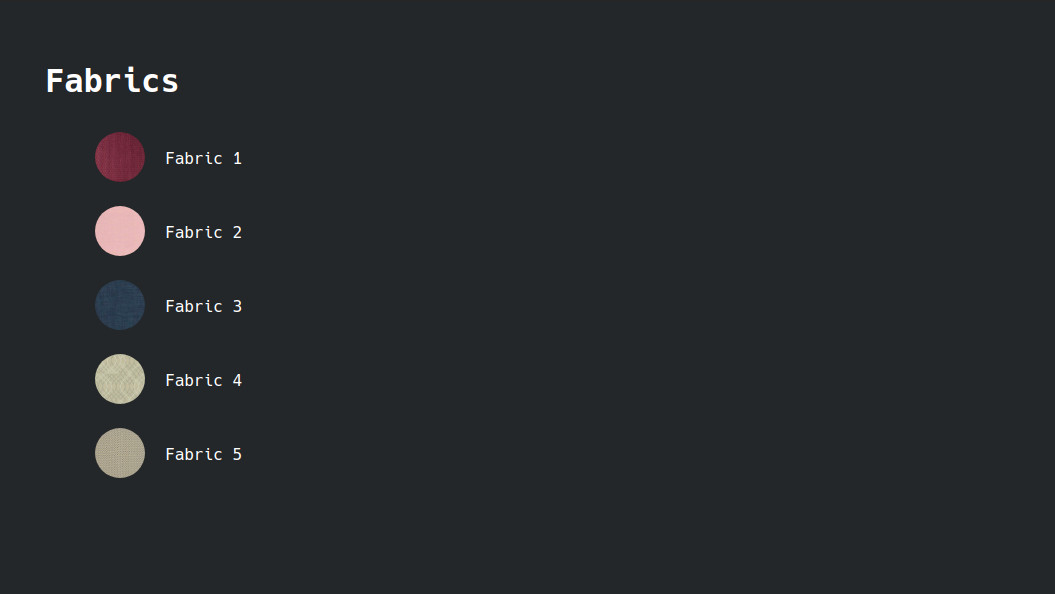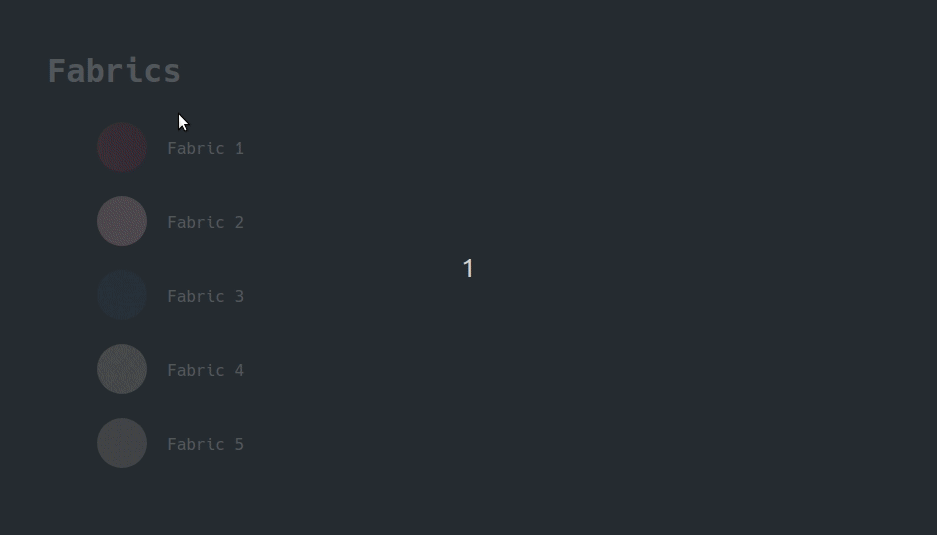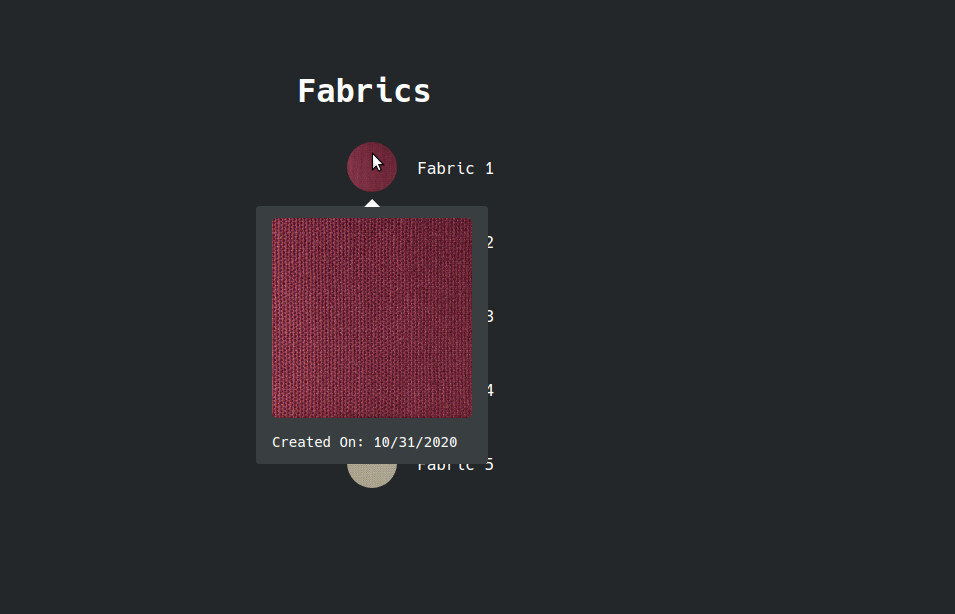Demo Application - Hosted on a Free dyno. (May take 10-20 seconds to wake up)
Github - Git repo for the hosted application.
Tools
- Ruby on Rails 6.0.2.2 - Ruby Web Framework
- StimulusJS - A minimal Javascript framework developed by Basecamp.
- Webpacker - Rails gem for using Webpack to bundle assets including Javascript modules.
- Tippy.js - Popup Javascript library.
Set Up
This tutorial assumes that you have a Rails application with webpacker and stimulus installed (along with some familiarity using each).
If you are using Rails >= 6.0 version, you can generate the application with the following command.
rails new sample_app --webpacker=stimulus
The model we will be working with from the demo is Fabric.
We have a typical index listing of the Fabric in the system:
app/views/fabrics/_fabric.html.haml
%li
.avatar
= img_pack_tag(fabric.image, class: "circular")
.data
= fabric.name

However, the avatar is too small for comparing fabrics, and it would be nice to have the image enlarged when hovering over it.
We will need to install a popup library to accomplish the desired feature.
Install with Yarn & Webpacker
Add the Tippy.js library using yarn
Command Line
yarn add tippy.js
Afterwords, create a scss file to load the module’s styles:
app/javascript/stylesheets/popup.scss
@import 'tippy.js/dist/tippy.css';
.popup {
padding: 7px;
.image {
text-align: center;
margin-bottom: 10px;
img {
height: 200px;
width: 200px;
border-radius: 5px;
}
}
}
NOTE: If you do not use a css style path such as
app/javascripts/stylesheets/in your build, you can load the the Tippy.js library styles in thepacksfile:
app/javascripts/packs/application.js
import 'tippy.js/dist/tippy.css';
Stimulus Integration
app/javascript/controllers/popup_controller.js
import { Controller } from "stimulus";
import tippy from 'tippy.js';
import "../stylesheets/popup.scss";
export default class extends Controller {
static targets = ["trigger", "content"]
initialize() {
this.initPopup();
this.contentTarget.style.display = "none";
}
initPopup() {
tippy(this.triggerTarget, {
content: this.contentTarget.innerHTML,
allowHTML: true,
});
}
}
We load the tippy module at the top of the stimulus controller file along with the stylesheet:
NOTE: Do not load the stylesheet if already imported in
app/javascript/packs/application.js
import tippy from 'tippy.js';
import "../stylesheets/popup.scss";
We have two stimulus targets:
static targets = ["trigger", "content"]
-
this.triggerTargetThis is the HTML element we will be passing into the
tippy()function. It will turn the element into a trigger for the popup component. -
this.contentTargetThis is the HTML content that the popup will contain.
We use the initialize() stimulus life-cycle function:
initialize() {
this.initPopup();
this.contentTarget.style.display = "none";
}
In the initPopup() method, we set this.popup to the return call of tippy() in order to access the popup:
initPopup() {
this.popup = tippy(this.triggerTarget, {
content: this.contentTarget.innerHTML,
allowHTML: true,
});
}
The first argument passed into the tippy() function is the element that will toggle the popup. In this case our this.triggerTarget.
The second argument is a options object.
this.contentTarget.innerHTMLis set as thecontentoption.- In order to allow for HTML rendering from Tippy.js we set the the
allowHTMLoption totrue.
Additional options can be found at Tippy.js README.
To prevent from the content from rendering outside the popup we hide it:
this.contentTarget.style.display = "none";
HAML View Changes
Now we have to update our fabric partial to utilize the popup controller:
app/views/fabrics/_fabric.html.haml
%li
.avatar{ data: { controller: :popup, target: "popup.trigger" } }
= image_pack_tag(fabric.image, class: "circular")
%div{ data: { target: "popup.content" } }
.popup
.image
= image_pack_tag(fabric.image)
.data
Created On:
= display_date fabric.created_at
.data
= fabric.name.titleize

Looks Good!
Now lets do some refactoring to clean up our view and make the popup controller more modular.
app/javascript/controllers/popup_controller.js
import { Controller } from "stimulus";
import tippy from 'tippy.js';
import "../stylesheets/popup.scss";
export default class extends Controller {
static targets = ["trigger", "content"]
initialize() {
this.trigger = this.getTrigger();
this.content = this.getContent();
this.initPopup();
this.content.style.display = "none";
}
initPopup() {
this.popup = tippy(this.trigger, {
content: this.content.innerHTML,
allowHTML: true,
});
}
getContent() {
if (this.hasContentTarget) {
return this.contentTarget;
} else {
var content = document.createElement('div')
content.innerHTML = this.data.get("content");
return content
}
}
getTrigger() {
if (this.hasTriggerTarget) {
return this.triggerTarget;
} else {
return this.element;
}
}
}
app/views/fabrics/_fabric.html.haml
%li
.avatar{ data: { controller: :popup,
popup: { content: render("popup", fabric: fabric) } } }
= image_pack_tag(fabric.image, class: "circular")
.data
= fabric.name.titleize
app/views/fabrics/_popup.html.haml
.popup
.image
= image_pack_tag(fabric.image)
.data
Created On:
= display_date fabric.created_at
